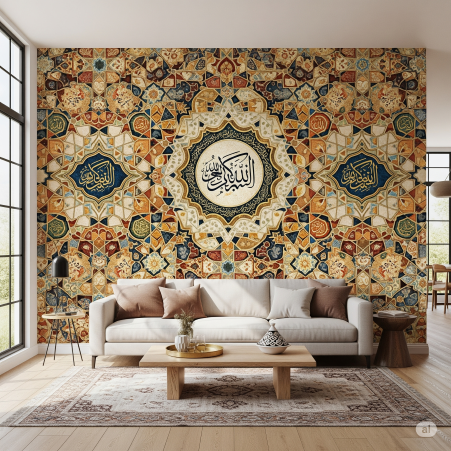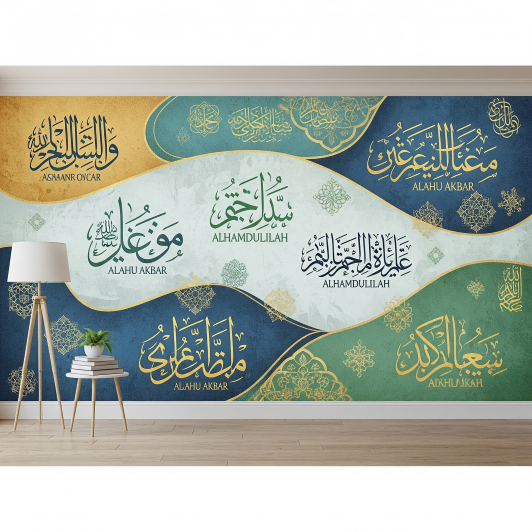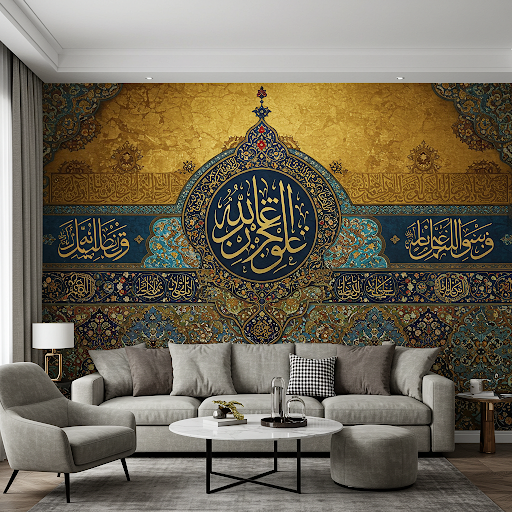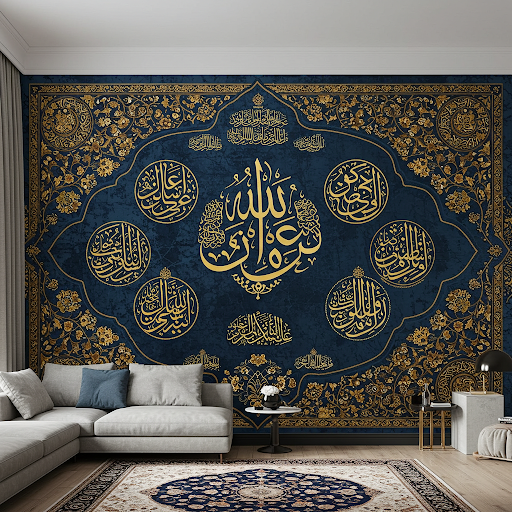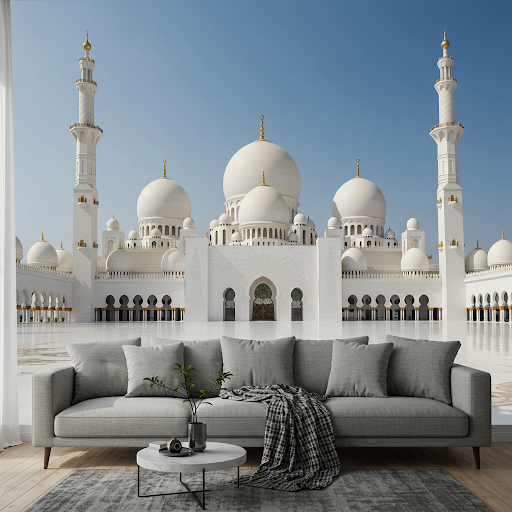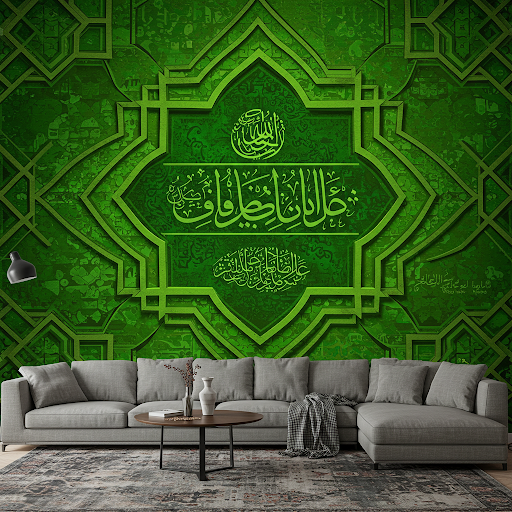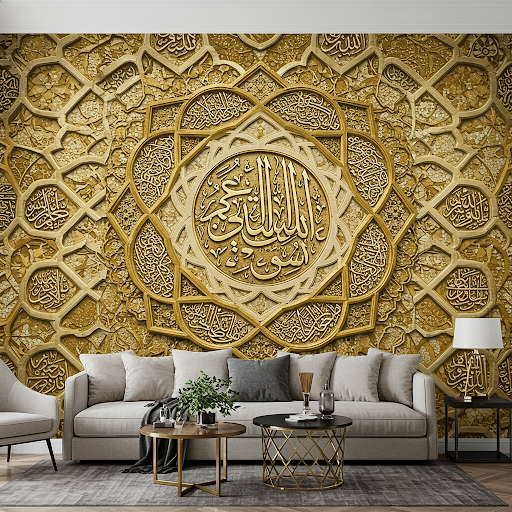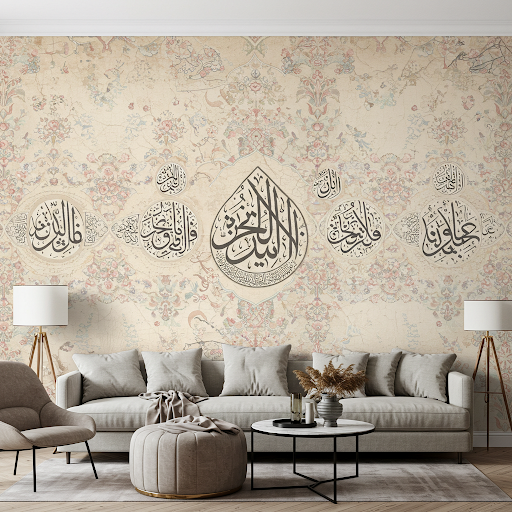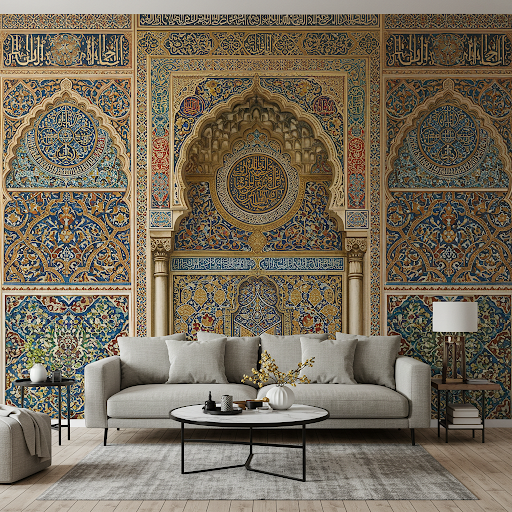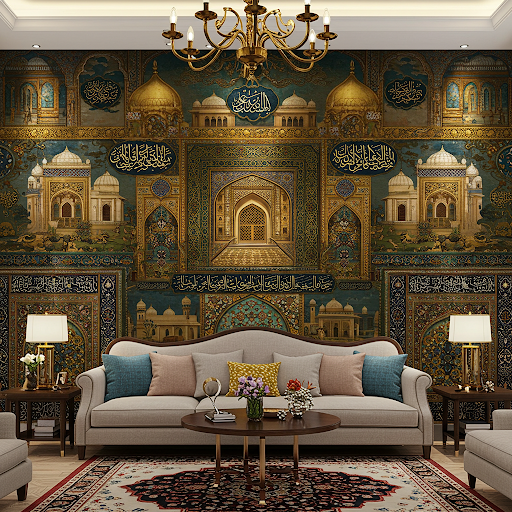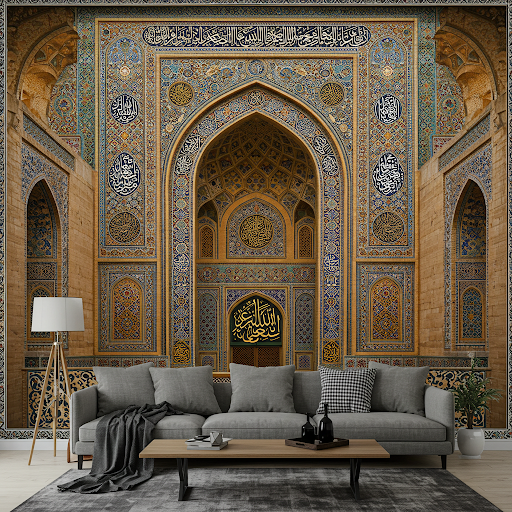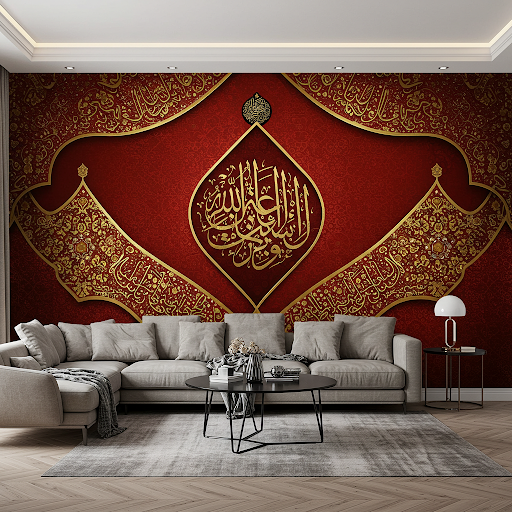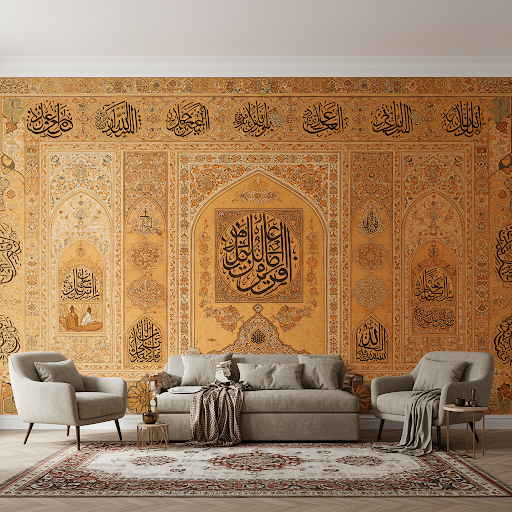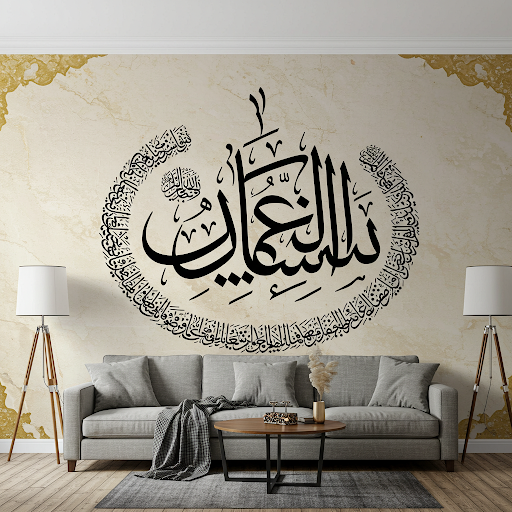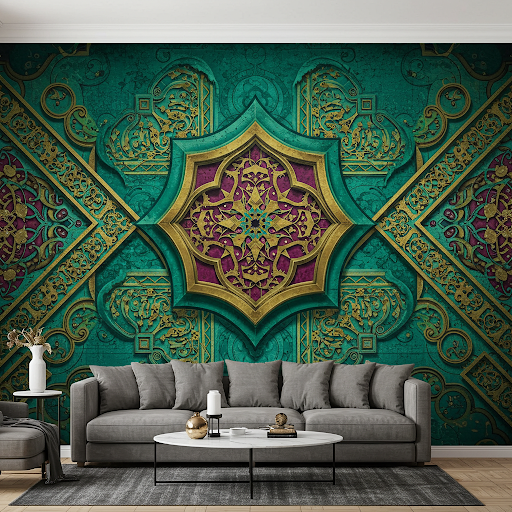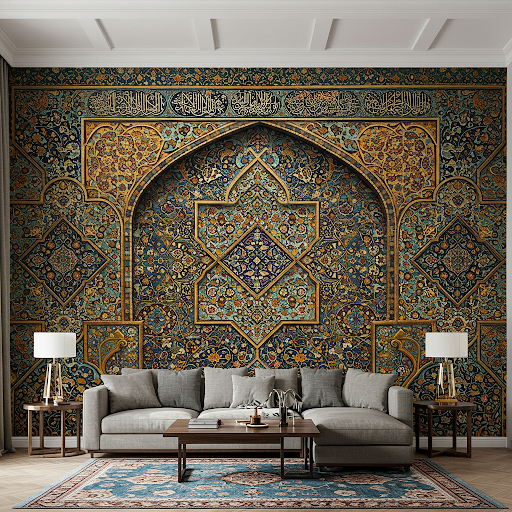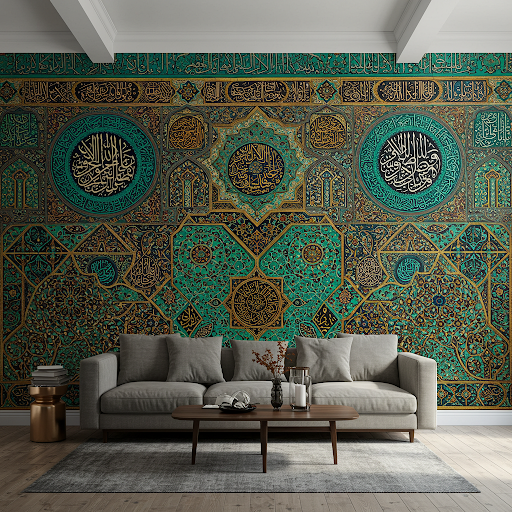Description
Islamic wall art, as a part of the broader category of Islamic art, is a rich and diverse form of artistic expression that has evolved over centuries. It is not merely decorative; it often carries deep spiritual and cultural significance, reflecting the core principles of Islam.
Islamic wall art encompasses a wide range of visual arts produced by people living in lands inhabited or ruled by Muslim populations since the 7th century CE. It is not defined by a single style but rather by a set of shared principles and recurring motifs.
A key principle of traditional Islamic art is its focus on non-representational forms. While figural representations of humans and animals were historically found in some secular contexts, particularly in palace settings and illustrated manuscripts, they are generally avoided in religious art to prevent idolatry. This principle elevates the importance of other artistic elements, which are used to express the divine without relying on figurative imagery.
Islamic Wall Art Design Principles and Motifs
The designs in Islamic wall art are characterized by three primary components that are often used in combination:
1. Artistic Islamic Calligraphy
Islamic calligraphy is a revered art form because it transforms religious texts into a spiritual and aesthetic experience. Rather than a simple communication tool, it becomes a method of venerating the divine word. The use of various scripts, such as Kufic, Thuluth, and Naskh, allows for a wide range of artistic expression. Each style has its own unique characteristics and historical context.
For example, Kufic is one of the oldest scripts, known for its angular and geometric forms. But Thuluth is a more cursive and ornamental script often used for monumental inscriptions.
By weaving together these scripts with verses from the Quran and other sacred phrases, calligraphic designs become more than just decoration. They are a form of devotion and a constant reminder of faith. This art form embodies the core Islamic principle that beauty and spirituality are interconnected.
2. Islamic Wall Art: Geometric Patterns
Islamic geometric patterns are a key element of Islamic art, deeply rooted in both decorative and theological principles. They go beyond simple decoration, serving as a symbolic representation of profound Islamic concepts.
Symbolism and Philosophy
The use of repeating and interlocking polygons, stars, and circles in these patterns symbolizes the infinite and transcendent nature of Allah. The patterns often appear to have no beginning or end, which reflects the eternal and limitless existence of God. This is also tied to the Islamic concept of Tawhid (the oneness of God). The intricate designs, despite their complexity, are a cohesive and unified whole. The symmetry and repetition in these patterns create a sense of harmony and order, mirroring the perceived order of the cosmos and the divine creation.
Design Principles
These patterns are meticulously constructed using a compass and a ruler, based on precise mathematical principles. The designs are typically built from a simple grid. And then expanded through a process of tessellation, where shapes fit together without any gaps or overlaps. This mathematical precision and inherent order are central to the art form. Common shapes include:
Circles
A circle’s lack of a beginning or end symbolizes the infinite and eternal nature of Allah. This form is a direct representation of Tawhid (the oneness of God), as it represents a single, complete, and indivisible whole from which all creation originates and returns.
Squares and Polygons
These shapes often form the foundational grid for the patterns. The square, with its four sides, represents the material world and its four cardinal directions and elements (earth, air, fire, water). Polygons, built upon this foundation, symbolize the order and stability of the physical realm, reflecting a divinely ordered cosmos.
Stars
Stars are a prominent motif in Islamic art, with the number of points holding specific significance. An 8-pointed star, for example, is common and is often referred to as the “Khatim Sulayman” (Seal of Solomon) in some traditions, symbolizing creation and the divine throne. A 10-pointed star is also frequently used. These stars symbolize a divine light or a central point from which all aspects of the universe emanate.
This careful use of geometry creates a visual rhythm that is both calming and captivating, drawing the viewer into a meditative state and encouraging contemplation of the divine. This art form, therefore, serves as a form of spiritual expression, a visual language that communicates complex theological ideas.
3. Vegetal/Floral Patterns (Arabesque)
The arabesque is a flowing, curvilinear motif composed of stylized leaves, vines, and flowers. These designs are often found spiraling and branching in complex, rhythmic patterns that appear to have no beginning or end. The arabesque symbolizes the lush gardens of Paradise and the organic beauty of creation, offering a sense of vitality and abundance.
These three elements are often combined to create a complete and cohesive visual language. For example, calligraphic panels might be framed by intricate geometric and arabesque borders, or floral motifs might be arranged within a geometric framework.
Islamic Wall Art Application and Historical Examples
Islamic wall art is integral to the design of mosques and other religious buildings, serving not only a decorative purpose but also a spiritual one. The application of these principles transforms architectural spaces into environments that reflect the core beliefs of Islam.
Monumental Calligraphy
Calligraphy is considered the highest form of Islamic art as it gives visual form to the divine word of God. The interiors and exteriors of mosques are often inscribed with monumental Quranic verses and prayers in various scripts, most notably the angular Kufic and the more fluid Thuluth. This practice visually reinforces the mosque’s function as a place of worship and study. The script itself is often stylized and intertwined with geometric or floral patterns, making the text a part of the overall decorative scheme.
Geometric and Arabesque Patterns
The use of intricate geometric tilework, such as the famous Iznik tiles from the Ottoman Empire, is a hallmark of mosque decoration. These tiles, often featuring a palette of cobalt blue, turquoise, and red, cover vast surfaces like walls, domes, and mihrabs (prayer niches). This repetition of patterns symbolizes the infinite nature of God and the order of the cosmos, creating a harmonious and contemplative atmosphere for worshippers. Similarly, arabesque patterns, which are intricate, scrolling designs of stylized plant forms, symbolize the continuous and unfolding growth of creation.
The Dome of the Rock
The Dome of the Rock in Jerusalem is a prime historical example of these principles in action. Completed in the late 7th century, its interior is decorated with stunning mosaics that are among the earliest surviving examples of Islamic wall art. These mosaics, which draw from earlier Byzantine and Sasanian traditions, intentionally avoid human or animal figures. Instead, they feature intricate floral motifs, vegetal scrolls, and images of jewelry and crowns, which are believed to symbolize the spoils of a triumphant Muslim civilization.
The mosaics also include extensive Quranic inscriptions in Kufic script. These are the earliest surviving examples of verses from the Quran in an architectural context. Their inscriptions emphasize the oneness of God (Tawhid) and the role of Jesus as a prophet, directly engaging with the Christian and Jewish heritage of Jerusalem.
Palaces and Secular Structures
While traditional religious art eschews figural imagery, historical Islamic palaces often featured vibrant wall paintings with secular themes. Early examples from the Umayyad period, such as the palaces of Qusayr ‘Amra and Khirbat al-Mafjar, contain frescoes depicting kings, hunters, dancers, and mythological figures. These paintings reflected the luxury and sophistication of the court.
The Alhambra Palace in Spain showcases exquisite examples of wall decoration. With its walls adorned with endless tiles of repeating geometric patterns and muqarnas (ornamental vaulting).
Modern Applications
Modern Islamic wall art is a testament to the enduring appeal of traditional Islamic design principles, adapting them for contemporary living spaces. It serves as a bridge between rich cultural and religious heritage and modern aesthetics. Allowing individuals to infuse their homes and workplaces with spiritual and meaningful art.
Canvas Prints and Posters
The rise of digital printing has made Islamic art more accessible than ever. Artists now create modern interpretations of classic motifs, which are then reproduced on canvas prints and posters. This application is particularly popular because it offers a wide range of styles, from traditional and ornate to minimalist and abstract.
Arabic Calligraphy
This remains a central theme, with artists using modern fonts and styles to present Quranic verses, the names of Allah, or common Islamic phrases like “Alhamdulillah” (praise be to God) or “SubhanAllah” (Glory to God). These pieces often use bold colors, textured backgrounds, or a simple, elegant script to complement modern decor.
Geometric Art
The complex, tessellating patterns are reimagined in new color palettes and compositions, sometimes with a 3D or layered effect. These pieces can serve as a striking focal point, bringing a sense of order and harmony to a room.
Mosque Landscapes
Stunning photographs or digitally rendered images of iconic mosques, like the Masjid al-Haram in Mecca or the Blue Mosque in Istanbul, are popular. They evoke a sense of spiritual connection and nostalgia, serving as a reminder of sacred places.
Wall Decals and Murals
For a more integrated and flexible approach to decor, wall decals and murals offer a simple yet impactful solution. These applications allow for large-scale designs without the permanence of painting or tiling.
Modern Aesthetics with Traditional Elements
Decals can feature intricate calligraphy or geometric designs that can be easily applied and removed. Making them perfect for rental properties. Or for those who like to change their decor frequently. They can be used to frame a doorway, adorn a feature wall, or create a serene space in a prayer room.
Creating a Custom Look
Large-scale murals can be commissioned to cover an entire wall, transforming a space into a vibrant and spiritually inspired environment. This can include a repeating geometric pattern that mimics traditional tilework or a sweeping calligraphic mural of a Quranic verse.
Interior Design
Beyond standalone art pieces, Islamic patterns and motifs are being seamlessly integrated into the very fabric of interior design, blending traditional craftsmanship with contemporary trends.
Wallpapers and Tilework
Modern wallpapers feature repeating arabesque or geometric patterns, providing a subtle yet rich backdrop. Similarly, contemporary tile designs and mosaics, often made from new materials like laser-cut metal or acrylic, are used for kitchen backsplashes, entryways, or bathroom accents, offering a nod to classic Zellij and Girih tilework.
Decorative Pieces
Islamic-inspired designs are appearing in home decor items such as laser-cut metal wall hangings, decorative screens (Jali), and textiles. These elements allow homeowners to incorporate their faith and culture into their everyday surroundings in a sophisticated and understated way.
For example, a laser-cut “Bismillah” in a modern font can be a striking addition to an entryway. An intricately patterned rug can anchor a living room, blending Islamic artistry with a contemporary color scheme and furniture. This fusion of tradition and modernity creates spaces that are not only beautiful but also deeply personal and spiritually meaningful.

